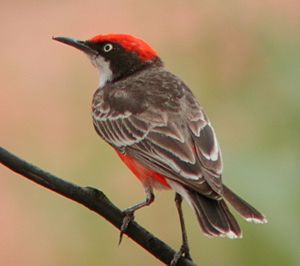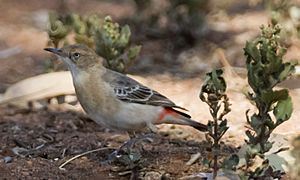Crimson chat facts for kids
Quick facts for kids Crimson chat |
|
|---|---|
 |
|
| Male | |
 |
|
| Female in Western Australia | |
| Conservation status | |
| Scientific classification | |
| Genus: |
Epthianura
|
| Species: |
tricolor
|
The crimson chat (Epthianura tricolor) is a small, colorful bird found in Australia. It's also known by other names like the tricoloured chat or saltbush canary. These birds are known for their bright colors, especially the males, and their interesting ways of finding food and raising their young in the Australian outback.
Contents
Description
Crimson chats are usually about 10 to 13 centimeters (4 to 5 inches) long. They weigh around 10 to 11 grams (less than half an ounce), which is very light! They have long, thin legs and a special bill that curves downwards. Their tongue is a bit like a brush, which helps them eat.
Adult male crimson chats have brown feathers on their backs. They have bright red crowns (the top of their heads) and red chests. Around their eyes, they have a black mask, and their throats are white. Female and younger chats look similar, but their colors are much paler. Males become even brighter during the breeding season to attract a mate.
Similar birds
Sometimes, people confuse the crimson chat with another bird called the male red-capped robin. The robin's scientific name is Petroica goodenovii. But there are a few ways to tell them apart. A male crimson chat has a red head and chest, a white throat, and a yellow eye. The red-capped robin, however, has a black body with a red chest and cap, white marks on its wings, and dark eyes. Also, the crimson chat's bill is thinner and longer than the robin's.
You can often find crimson chats near plants like saltbush, Spinifex, or mulga. These plants are common in the areas where these birds live. Luckily, the crimson chat is not an endangered bird. Its main threat is being hunted by predators.
Where they live and what they like
Crimson chats live in many different parts of central Australia. You can find them in deserts, dry areas, woodlands, grasslands, and even coastal shrublands. Their home stretches from the west coast all the way to the Great Dividing Range in the east. They also live from the tropical north down to the south coast.
These birds usually prefer drier places, often on the edges of wetter regions. They live in different types of shrubland, such as areas with saltbush, bluebush, acacia, and samphire plants. If there isn't enough rain, they will move to wetter areas. This is because dry conditions mean less food for them.
Crimson chats often travel far to find rain. This helps them find the best flowers and nectar to eat. They don't follow a regular migration pattern like some birds. Instead, they move around as needed to find food and water.
Behaviour
Crimson chats are usually seen in small groups. During the breeding season and the rest of the year, they often stay in pairs. They tend to walk more than they hop and are usually found on or near the ground.
What they eat
Crimson chats mainly eat insects and spiders. They find these on the ground or in shrubs. They can also use their special brush-like tongue to get nectar or seeds from flowers close to the ground.
How they breed
Crimson chats breed from August to October in the southern parts of Australia. In the drier northern regions, they can breed almost any time after it rains. These birds build their nests close together in groups. Both the male and female chats work together to protect their nests.
Their calls are usually soft, metallic sounds, like "dik-it-dik-it," or high-pitched whistles, like "see" or "seet." When they are upset, they make a quick "check-check" sound. This chattering sound is actually where their name, "chat," comes from!
Both parents help build a cup-shaped nest. It's usually placed low in a shrub or grass, close to the ground. They build it using grass, small roots, hair, feathers, and twigs. The female lays 2 to 4 eggs. These eggs are pink and white with brown-red spots and are about 17 by 13 millimeters (0.67 by 0.51 inches) in size.
Both parents take turns sitting on the eggs for about 12 to 13 days until they hatch. After the young birds hatch, both parents feed them for about two weeks. Then, the young birds are ready to fly and find food on their own. If a predator, like a cat, snake, fox, or a large bird like a raven, comes near the nest, one of the parents will pretend to be hurt. This helps distract the predator away from the nest and keep the babies safe.
Images for kids
See also
 In Spanish: Eptianuro tricolor para niños
In Spanish: Eptianuro tricolor para niños



